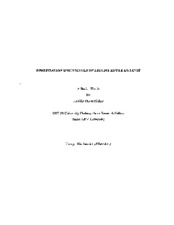| dc.contributor.advisor | Hu, James C. | |
| dc.creator | Rieker, Jennifer Dawn | |
| dc.date.accessioned | 2013-02-22T20:40:30Z | |
| dc.date.available | 2013-02-22T20:40:30Z | |
| dc.date.issued | 1998 | |
| dc.identifier.uri | https://hdl.handle.net/1969.1/ETD-TAMU-1998-Fellows-Thesis-R52 | |
| dc.description | Digitized from print original stored in HDR. Due to the character of the original source materials and the nature of batch digitization, quality control issues may be present in this document. Please report any quality issues you encounter to digital@library.tamu.edu, referencing the URI of the item. | en |
| dc.description | Includes bibliographical references: leaves 24-25. | en |
| dc.description | Program year: 1997/1998 | en |
| dc.description.abstract | The dimerization specificity of a leucine zipper is partially determined by the interactions of charged amino acids on the surfaces of dimer interfaces (e and g positions). A series of e and g position GCN4 mutants has been described that do not dimerize with the wild-type GCN4 but are able to dimerize with each other. Two hydrophobic leucine residues present in the wild-type GCN4 leucine zipper are suspected to be causing this difference in dimerization specificity. To determine the importance of these leucine residues in dimerization specificity, I constructed a series of mutants in which the leucine residues were substituted with alanine. The dimerization specificity of these mutants was determined based on the phenotypes of cells expressing wild-type and dominant negative λ repressor-leucine zipper fusion proteins. Cells that were immune to infection by phage λ contain homodimeric fusion proteins. Cells that were sensitive to infection by phage λ are forming heterodimeric fusion proteins. The two leucine residues in the wild-type GCN4 leucine zipper are not sufficient to explain the difference in dimerization specificity. | en |
| dc.format.extent | 42 pages | en |
| dc.format.medium | electronic | en |
| dc.format.mimetype | application/pdf | |
| dc.language.iso | en_US | |
| dc.rights | This thesis was part of a retrospective digitization project authorized by the Texas A&M University Libraries in 2008. Copyright remains vested with the author(s). It is the user's responsibility to secure permission from the copyright holder(s) for re-use of the work beyond the provision of Fair Use. | en |
| dc.subject | leucine zipper | en |
| dc.subject | dimerization specificity | en |
| dc.subject | alanine | en |
| dc.subject | phage λ | en |
| dc.subject | homodimeric fusion proteins | en |
| dc.subject | heterodimeric fusion proteins | en |
| dc.title | Dimerization specificities of leucine zipper mutants | en |
| dc.type | Thesis | en |
| thesis.degree.department | Biochemistry and Biophysics | en |
| thesis.degree.grantor | University Undergraduate Fellow | en |
| thesis.degree.name | Fellows Thesis | en |
| thesis.degree.level | Undergraduate | en |
| dc.type.material | text | en |
| dc.format.digitalOrigin | reformatted digital | en |


